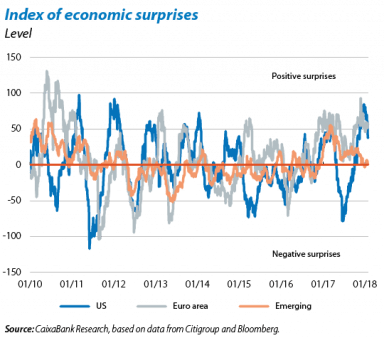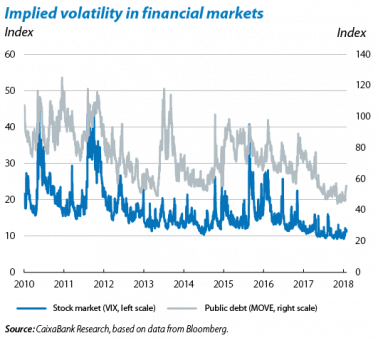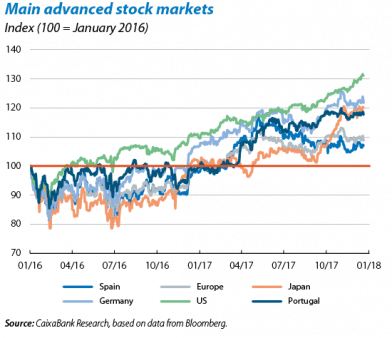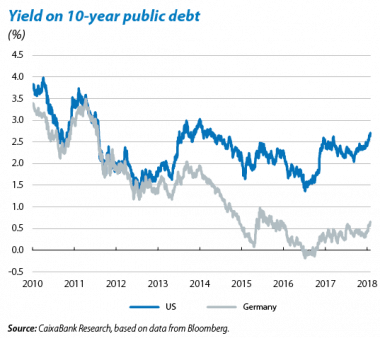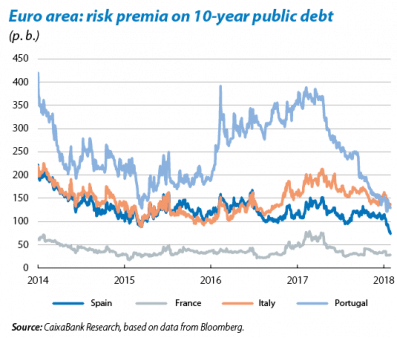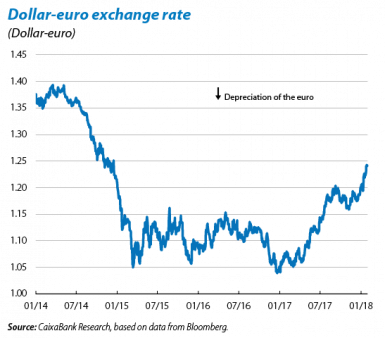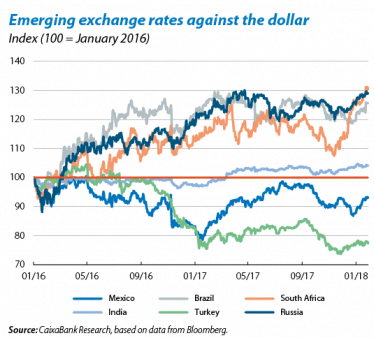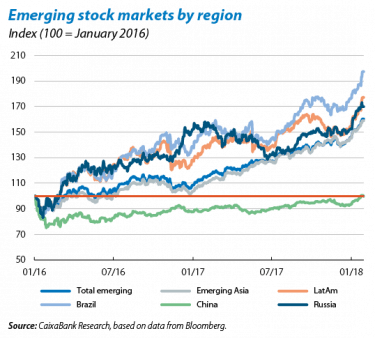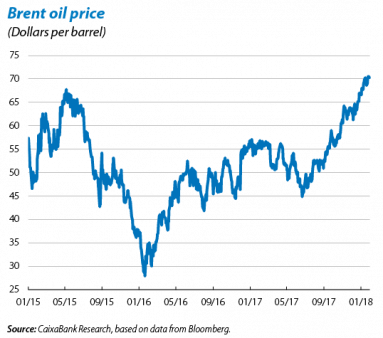A volatile start to the year for financial markets
A January of contrasts in the markets. Supported by strong macroeconomic data at the end of 2017 and improved growth prospects at the beginning of 2018, in January sovereign interest rates rose sharply, particularly in the US and the core euro area countries. At the same time, stock markets were bullish in the first few weeks of the month with considerable gains for the main indices in the US, Europe and emerging economies. Sovereign interest rates consolidated their gains after the first meetings in 2018 indicated few policy changes on the part of the European Central Bank (ECB) and as the US Federal Reserve (Fed) reinforced the expectation of three rate hikes over the next 12 months. However, on greater expectations of a gradual tightening of US financial conditions and the ECB moving towards monetary normalisation in 2018, the main international stock markets moderated their gains and started to post losses in the last few sessions of January.
Risk factors remain latent. High equity prices have benefitted from a scenario that combines good growth prospects and inflation expectations in the advance economies remaining subdued, supporting a gradual normalisation of interest rates. However, this environment could lead to excessive complacency, especially as there are overvaluation concerns in the US stock market. Also, the US is gradually entering a more mature phase of the cycle, and with its labour market at full employment there is a higher likelihood of upside risks for inflation and a heightened risk of a faster monetary policy tightening on behalf of the Fed. Finally, there are also latent geopolitical tensions (including conflicts between Iran and Saudi Arabia and between the US and North Korea) which, in 2017, had already led to temporary upswings in financial volatility.
From more to less in developed stock markets. Whereas stock markets started 2017 with losses, given the scenario of significant pockets of uncertainty, in 2018 most of the stock market indices of the developed economies began the year with a few weeks of high spirits and considerable gains. However, the mood started to change in the last sessions of the month and the main stock market indices posted losses in the last week of January. Nevertheless, US stocks continued to set records for January as a whole (the S&P 500 gained almost 6%), while, in the euro area, the Eurostoxx 50 rose by +3.0% and the Italian MIB by +7.6%, the Spanish Ibex 35 by +4.0%, the Portuguese PSI 20 by +3.4%, the French CAC 40 by +3.2% and the German DAX by +2.1%.
The Fed plans three interest rate hikes for 2018. As expected, at its first meeting of the year the Fed did not alter the parameters of its monetary policy and kept the fed funds rate unchanged within the range of 1.25%-1.50%. However, after confirming, last December, the prospect of three further hikes in 2018, the Fed’s January meeting sent a message of continuity, albeit providing a slightly more positive view of the macroeconomic scenario. The members of the Federal Open Market Committee (FOMC) indicated that they expect inflation to rise throughout 2018 and stabilise, in the medium-term, around the 2% target. They therefore also repeated the need to continue gradually raising interest rates. After these messages of continuation, Janet Yellen held her last meeting as a member of the FOMC, which she has chaired since February 2014. Under her mandate the Fed has carried out five interest rate hikes since the Great Recession of 2007-2009 and put an end to the cycle of unconventional monetary policy by implementing, last October, a relatively automatic strategy of reducing the Fed’s balance sheet. Jerome Powell takes over as Fed Chair from 3 February.
The ECB repeats that it does not plan to raise interest rates until well past the end of QE. Although the December meeting of the ECB’s Governing Council (GC) did not provide any huge surprises, the publication of the meeting’s minutes at the beginning of January revealed the GC is planning to tighten its forward guidance. Investors interpreted this message as a hint that it was preparing the ground to end QE, kindling greater interest in the ECB’s January meeting. However, at the meeting held on 25 January, the GC kept its forward guidance unchanged and repeated that QE will continue at a rate of EUR 30 billion per month until at least September 2018. The ECB also reinforced expectations of no interest rate hikes until well past the horizon of the net asset purchases. Lastly, Draghi once again stressed that the exchange rate volatility observed in the past few months is a source of uncertainty for the euro area’s economy. He mentioned that, although a large part of this movement reflects Europe’s improved economic outlook, some is also due to the Trump administration’s use of language. On the whole, although the meeting did not provide any great changes, the ECB repeated that it believed the economic scenario was positive. Consequently, at its future meetings the GC is expected to adjust its forward guidance in preparation for ending net asset purchases by the end of the year.
Sovereign interest rates pick up while risk premia fall. Sovereign interest rates rose strongly, especially in the US (interest rates on 10-year Treasury bills rose by more than 30 bp to their highest level since 2014) and Germany. At the same time, the risk premia for euro area peripheral economies fell sharply. Specifically, the Spanish premium benefitted from Fitch’s upgrade of its sovereign rating on 19 January (from BBB+ to A), falling by more than 35 bp to its lowest level since 2009, fluctuating between 70 and 80 bp. Portugal’s risk premium fell by more than 20 bp, reaching its lowest level since 2010, while Italy’s risk premium also decreased by about 20 bp in spite of continuing uncertainty regarding the country’s general elections in March.
The dollar continues to depreciate. After the euro stabilised at around USD 1.18 in December, with the publication of the ECB’s minutes early in January, it started to appreciate again and ended the month at around USD 1.24. The dollar’s depreciation was not only against the euro but also against most emerging currencies. The Mexican peso appreciated considerably, up by around 6%, as well as the Brazilian real.
In addition to each region’s own idiosyncratic factors, the dollar’s movements coincided with political statements made by the Trump administration. In particular, the euro went above USD 1.25 after Steven Mnuchin, United States Secretary of the Treasury, pointed out the advantages of a weaker dollar. However, a few days later, when Trump backed a strong dollar, the US currency reacted by appreciating against the main currencies.
Emerging stock markets follow the tune of global investor sentiment. Emerging equity markets also started January with considerable gains. In the first three weeks of the year, the MSCI Emerging Markets index rose by more than 9%. Among the main emerging economies, the Russian index, RTS, posted notable gains, benefitting from higher crude prices and appreciating by more than 13%. Latin America’s gains were led by Brazil and Argentina while China’s stock market appreciated by over 7%. However, as with the advanced economies, emerging stock markets started to reverse the gains made during the last sessions of the month, accumulating losses of –1.5% for the emerging region as a whole. As a result, the MSCI Emerging Markets index for January as a whole saw a gain of 8.3%.
Another upswing in oil prices. The price of a Brent quality barrel continued its upward trend observed in the last week of 2017, almost reaching USD 70. This was clearly supported by the extension of OPEC’s production ceiling agreement, announced at the end of November 2017. Also, in the past few weeks various temporary factors, such as the weak dollar and geopolitical tensions between Saudi Arabia and Iran, have joined investor optimism in driving up the price of crude.
